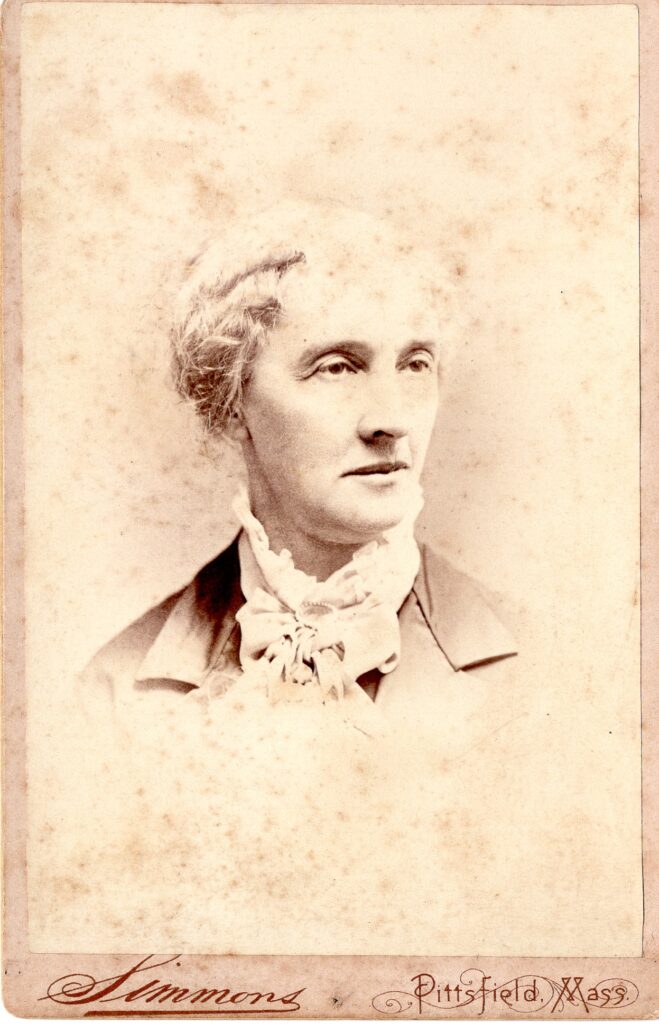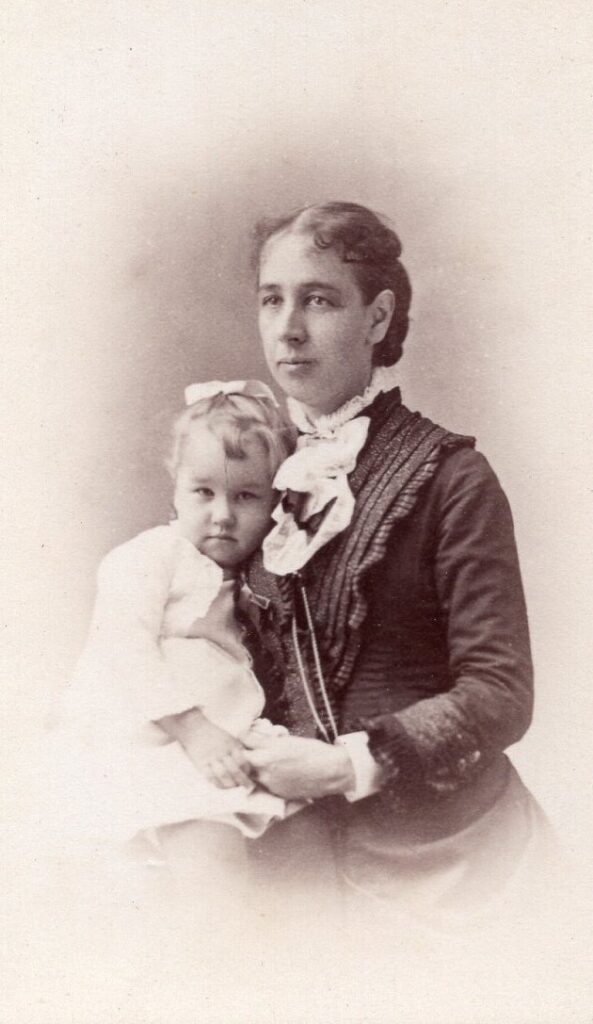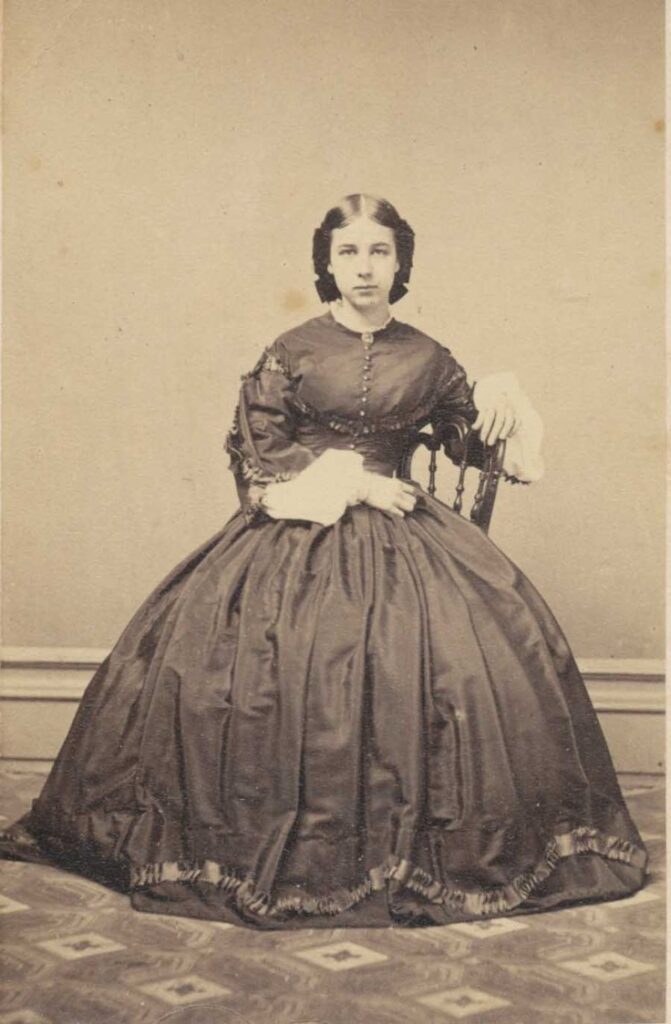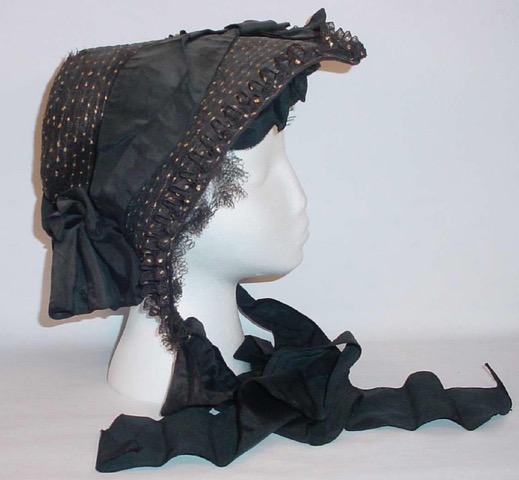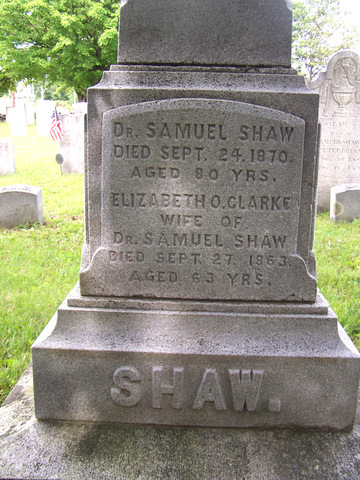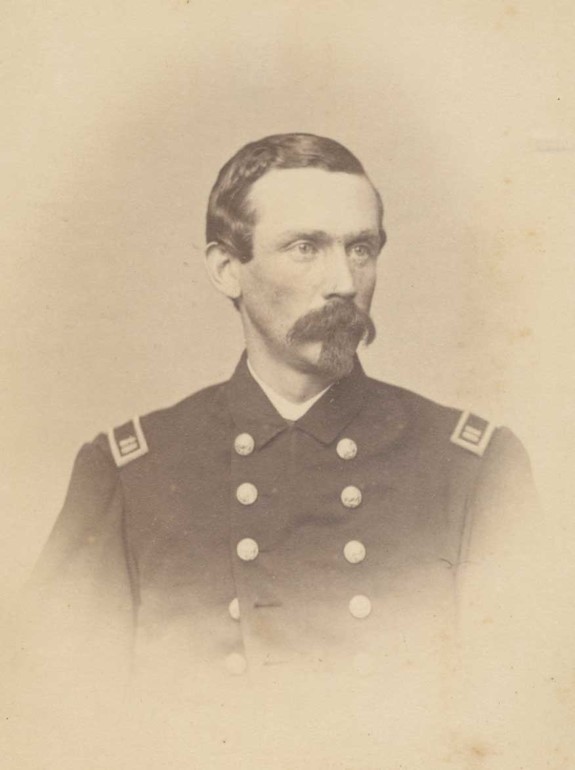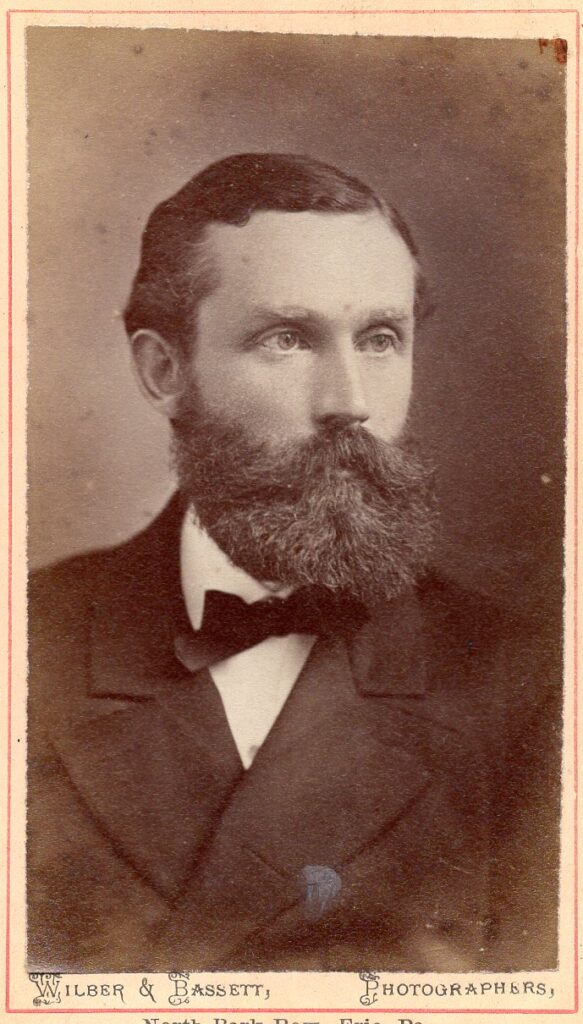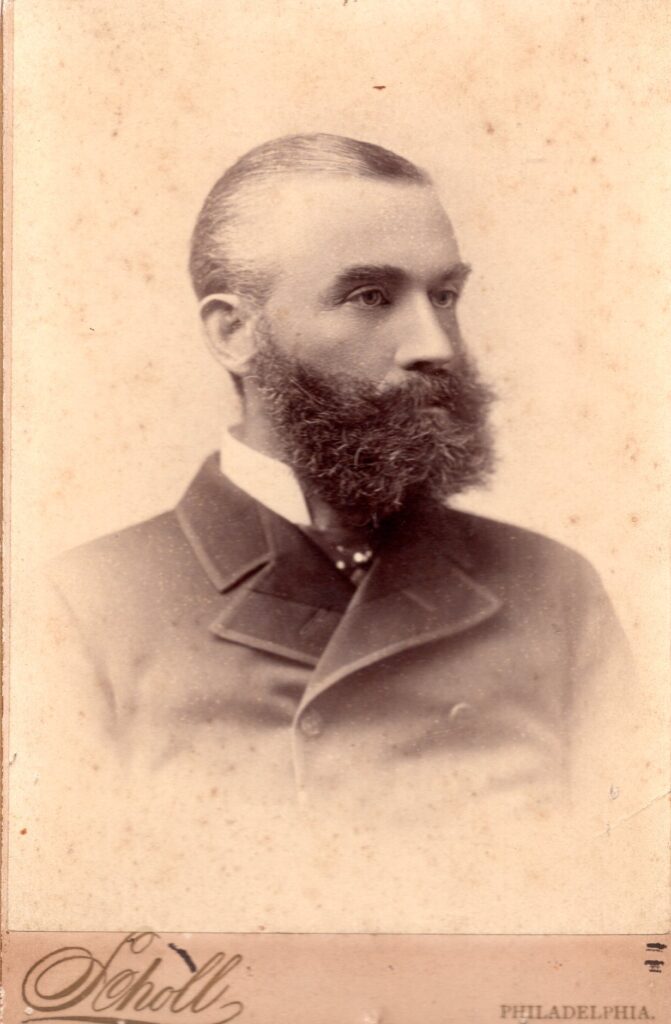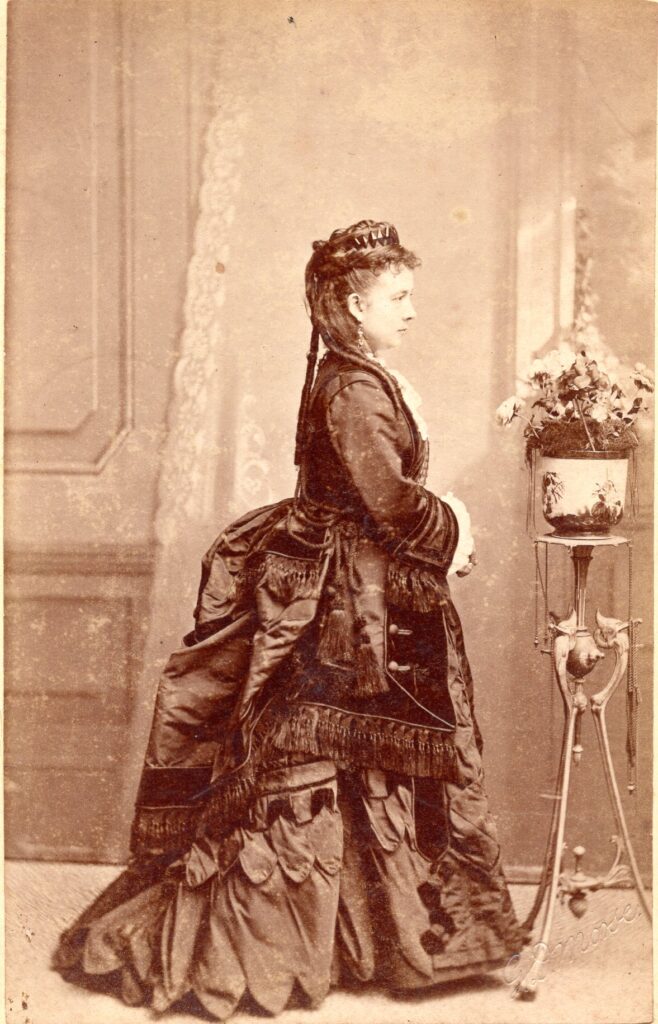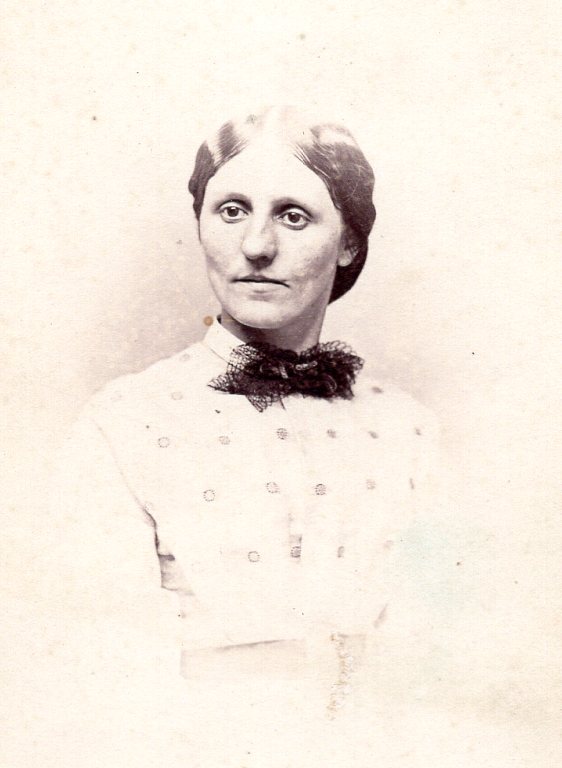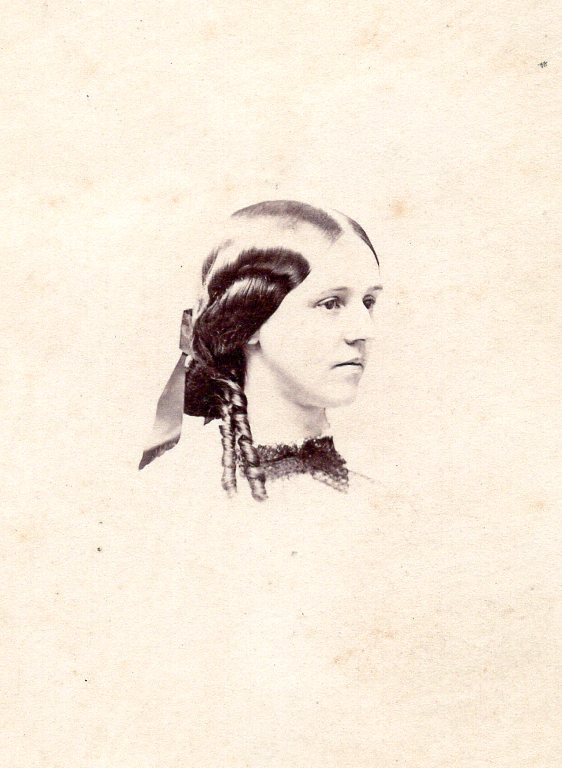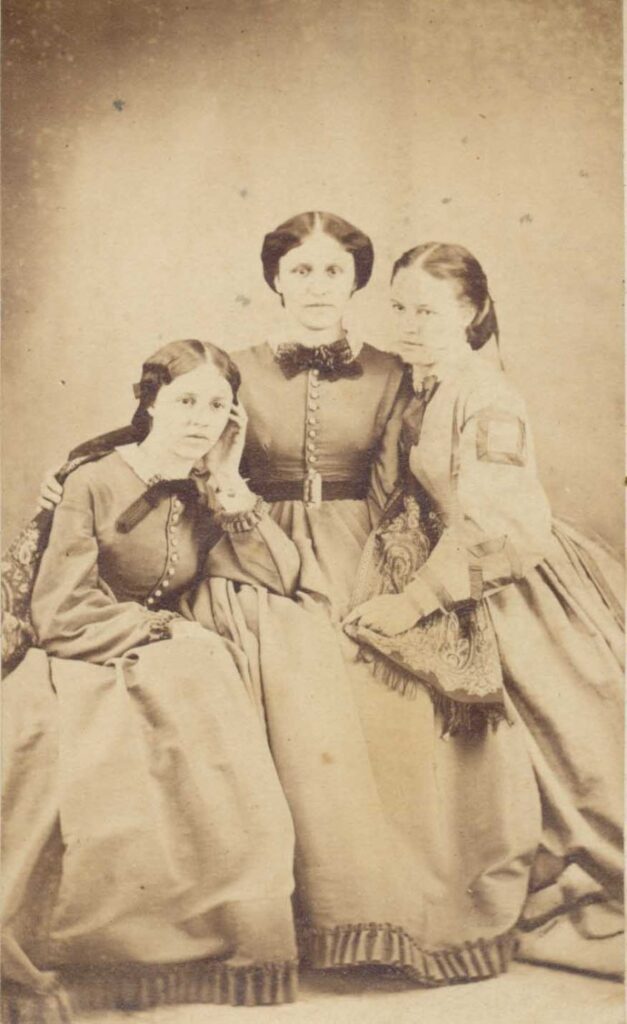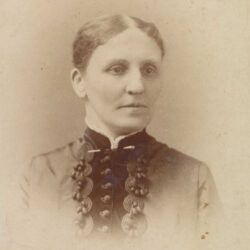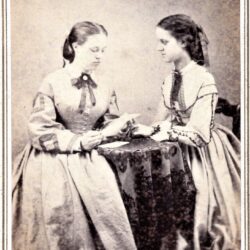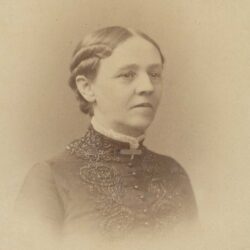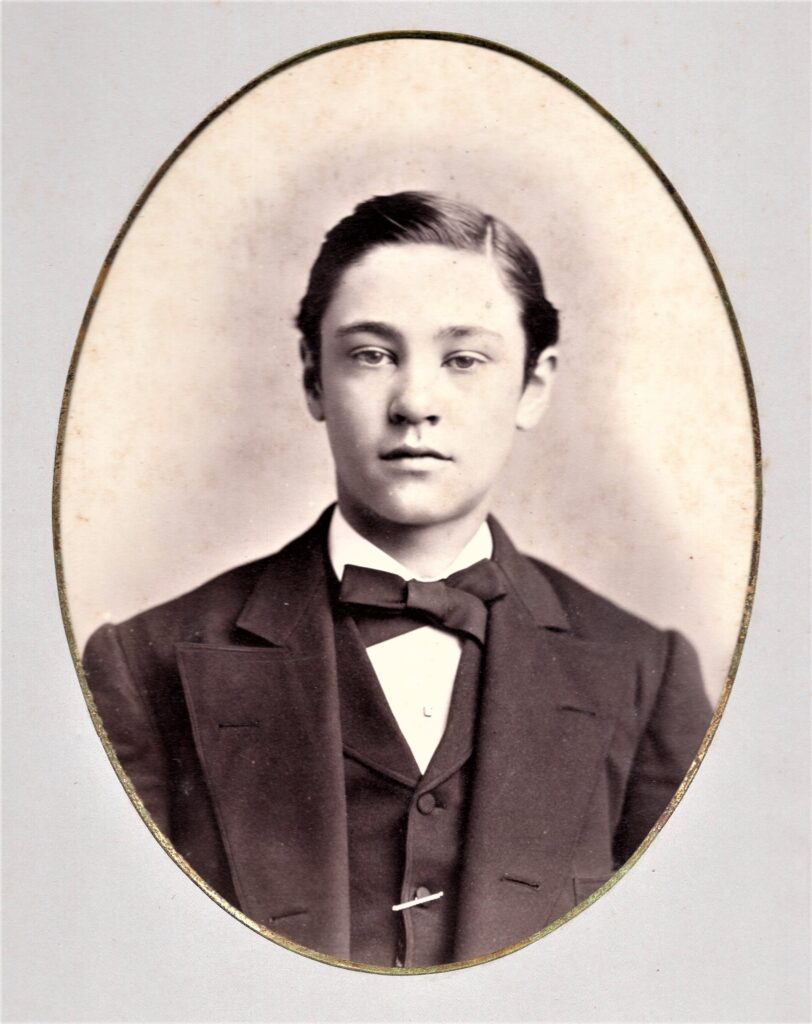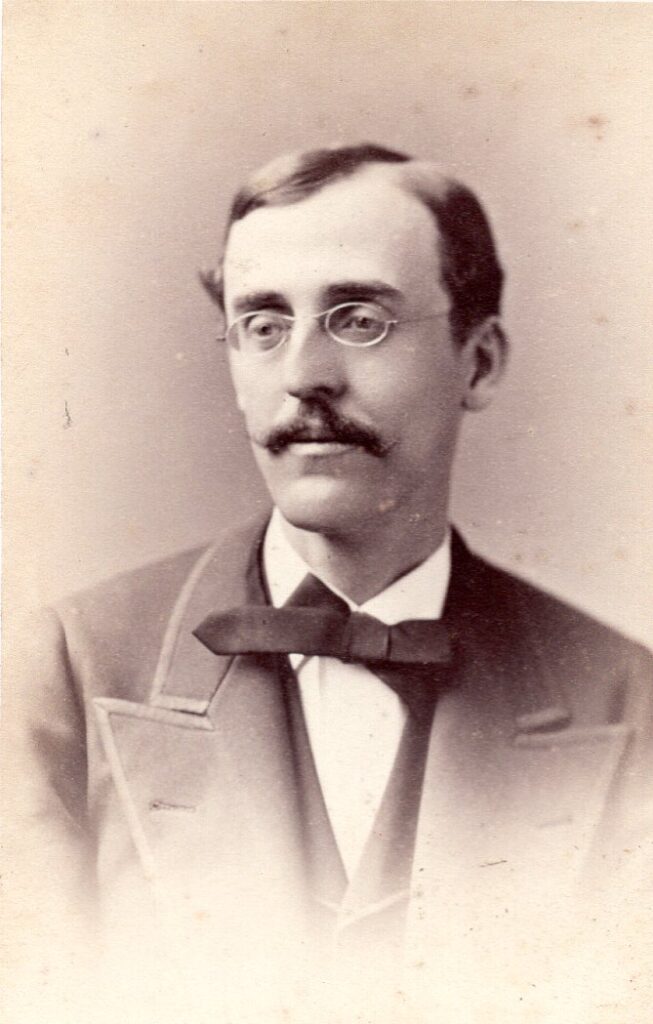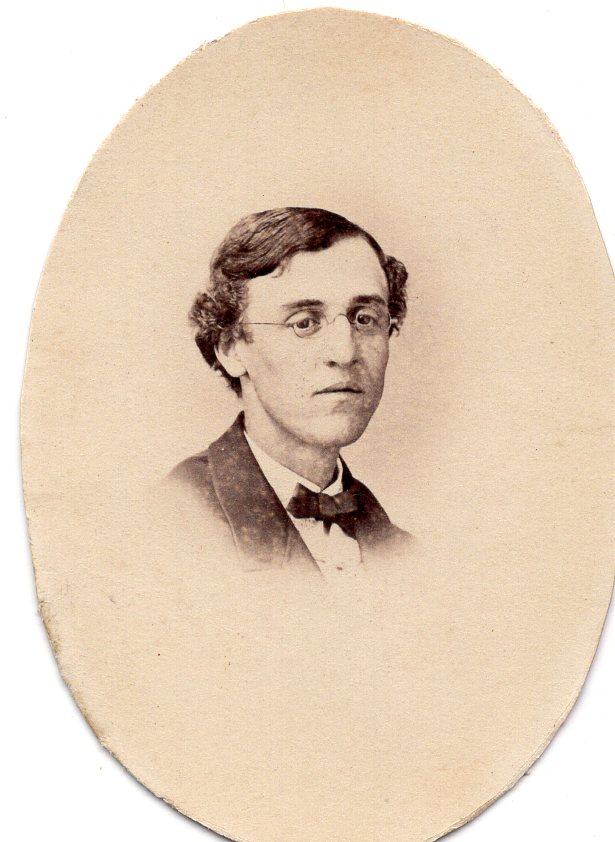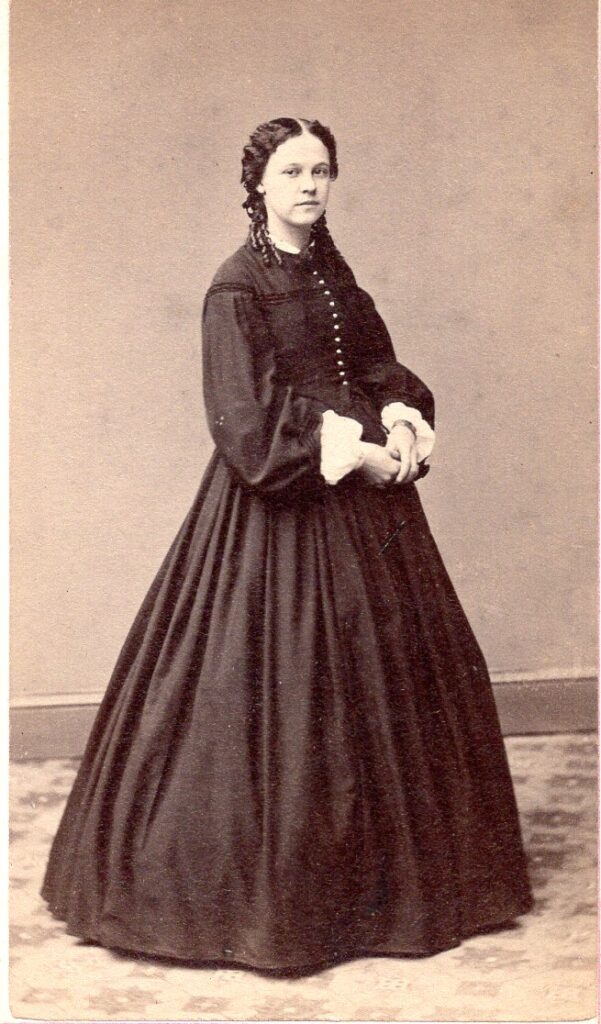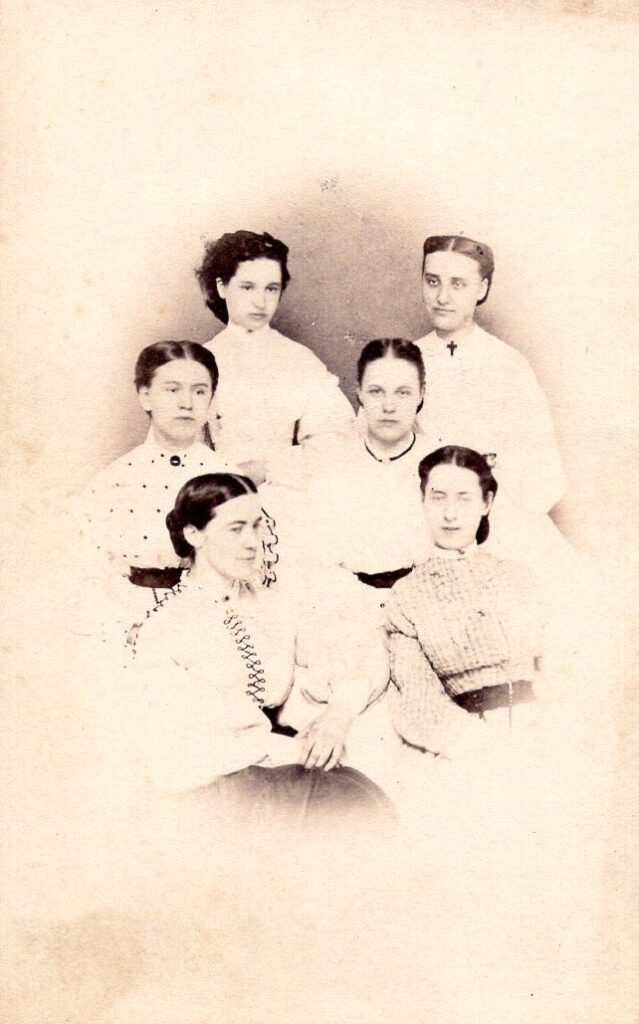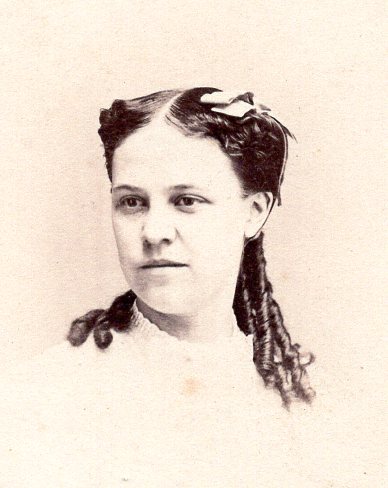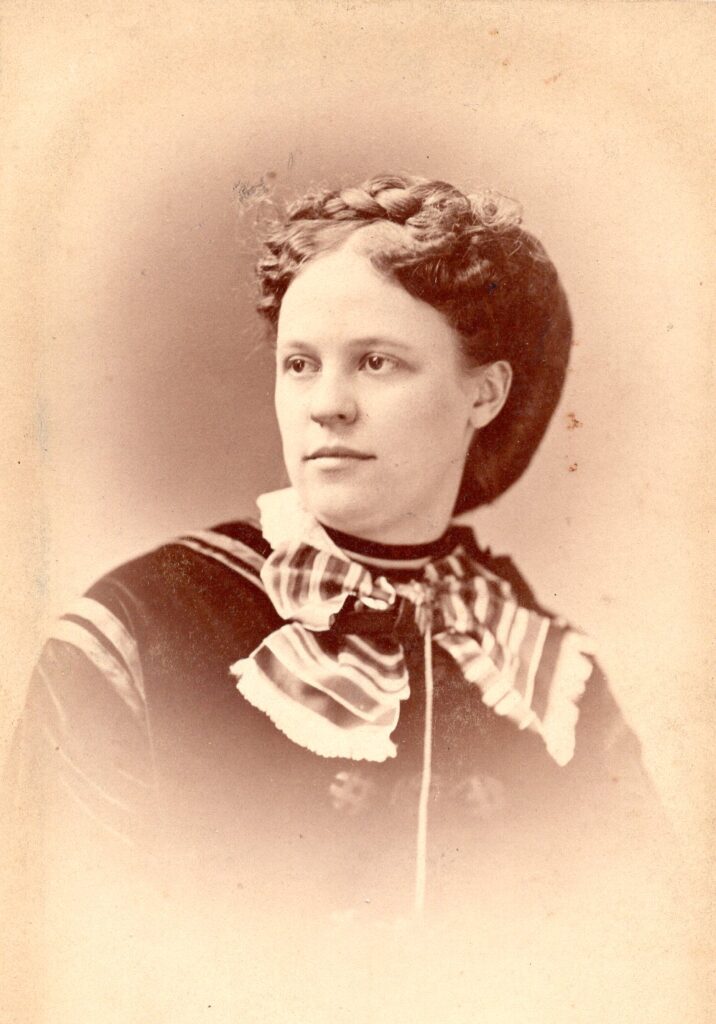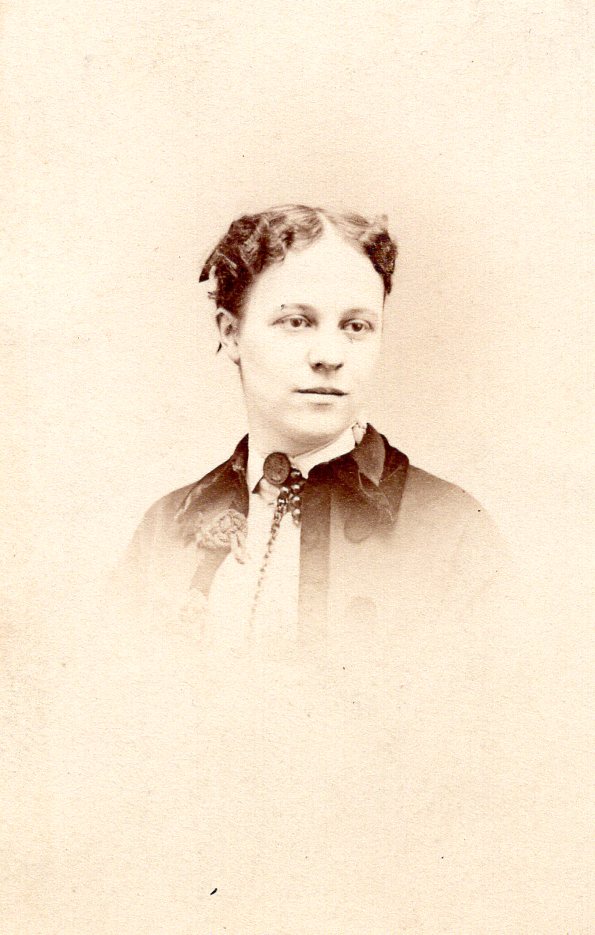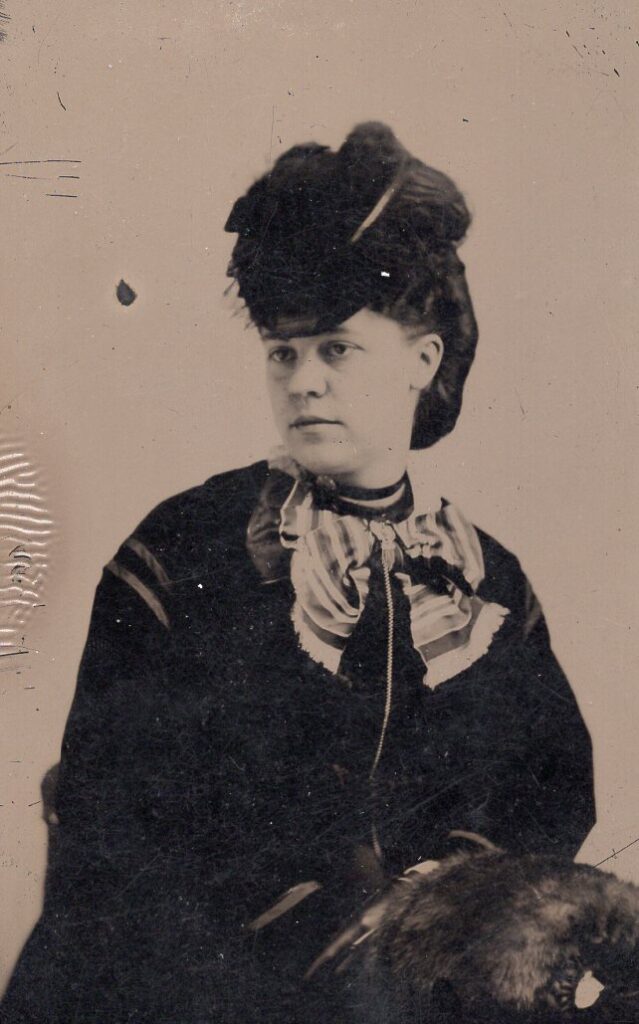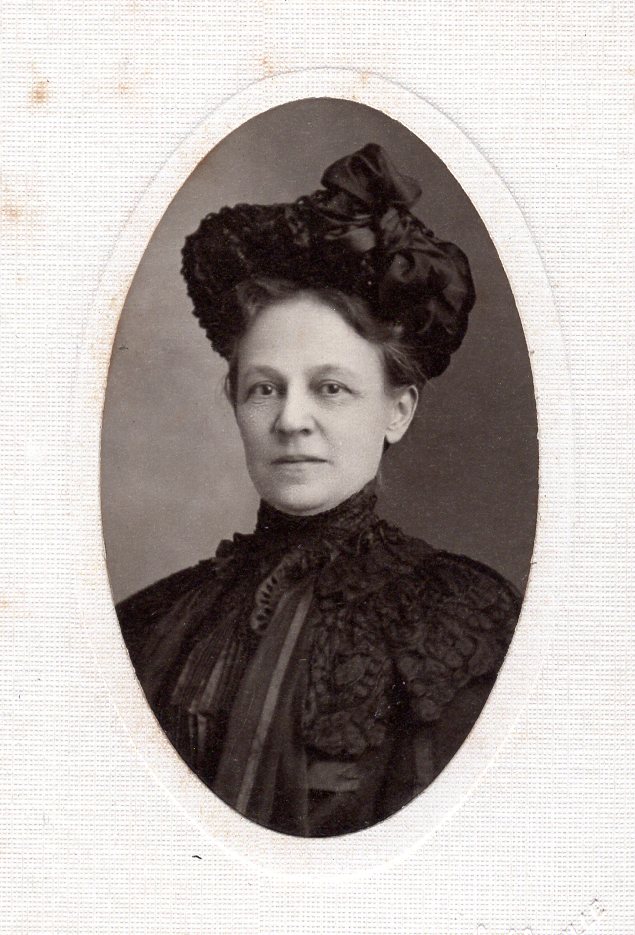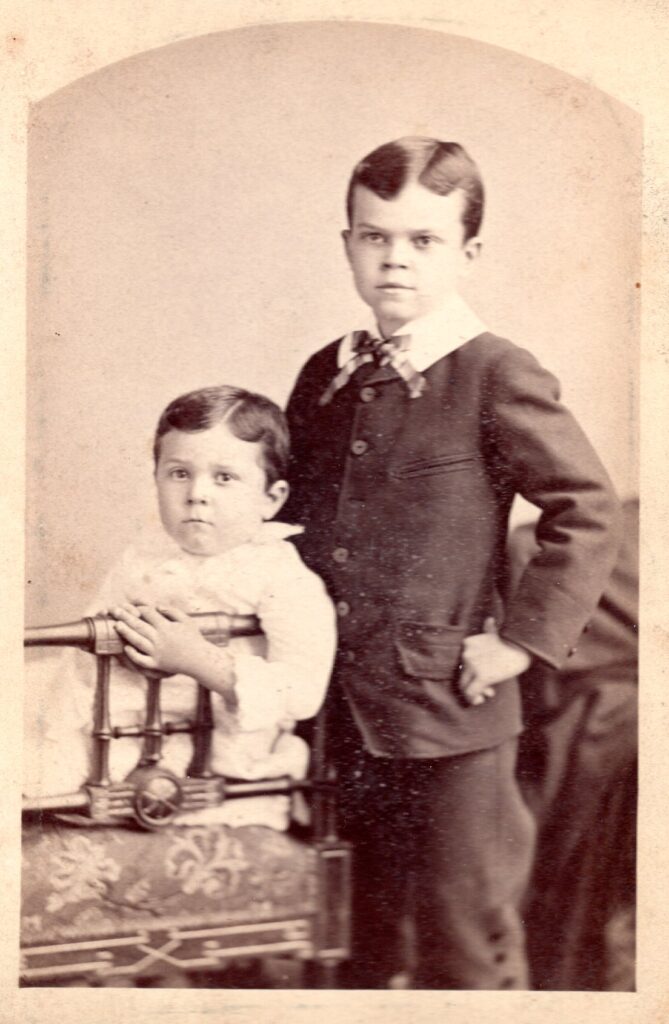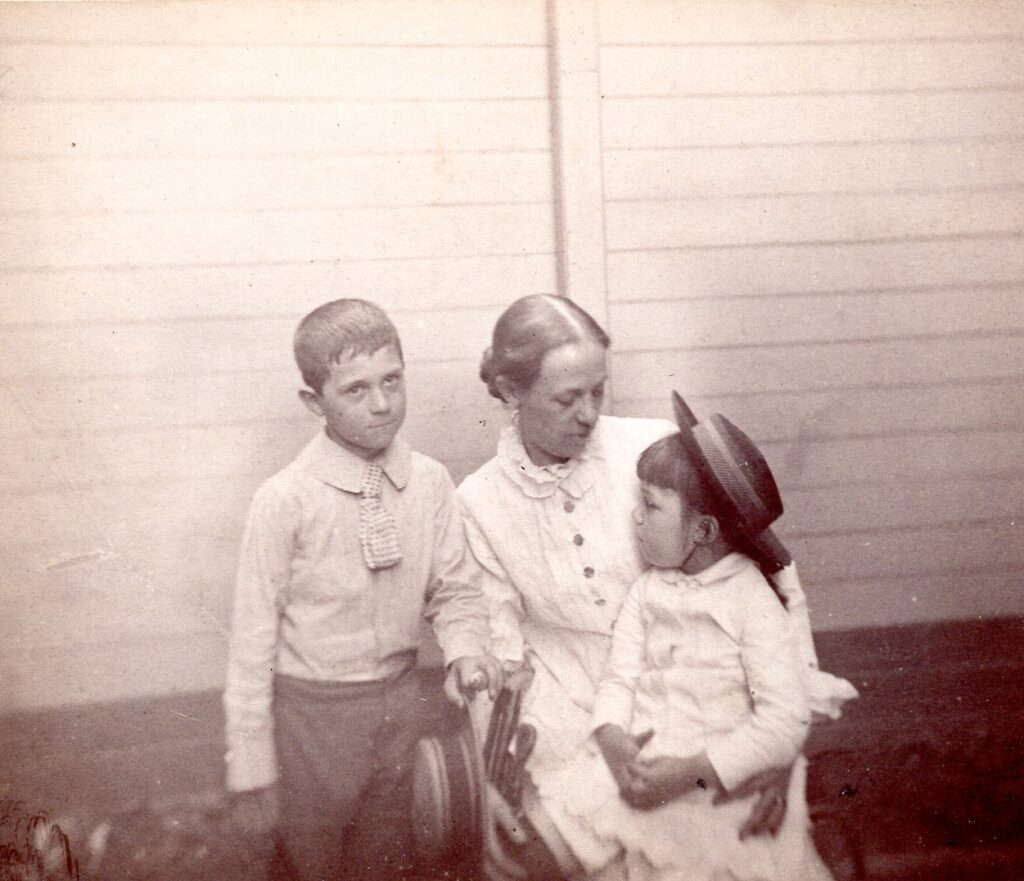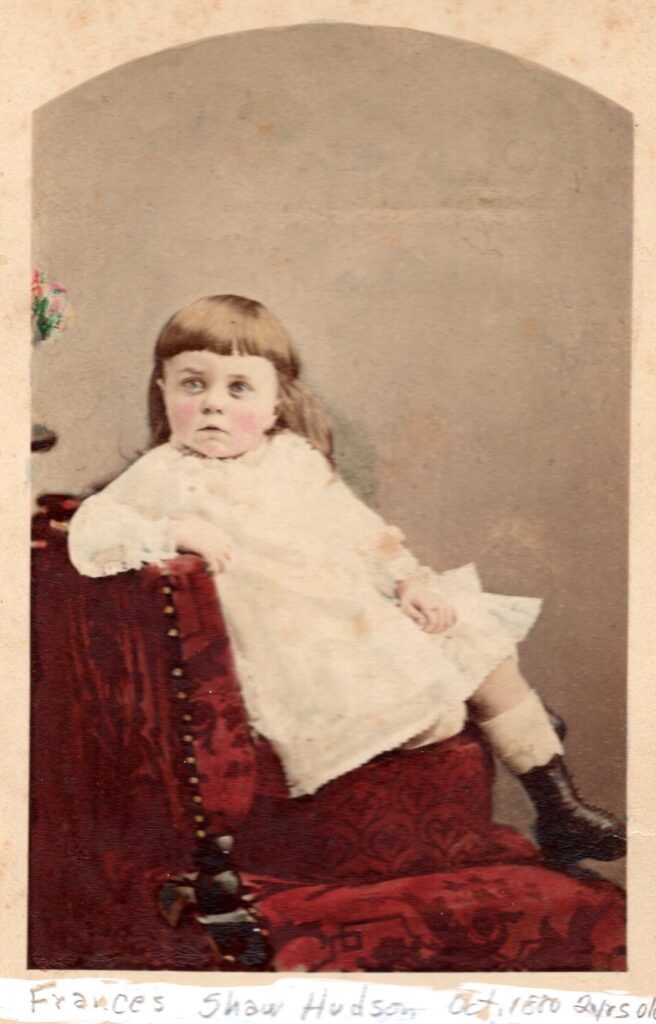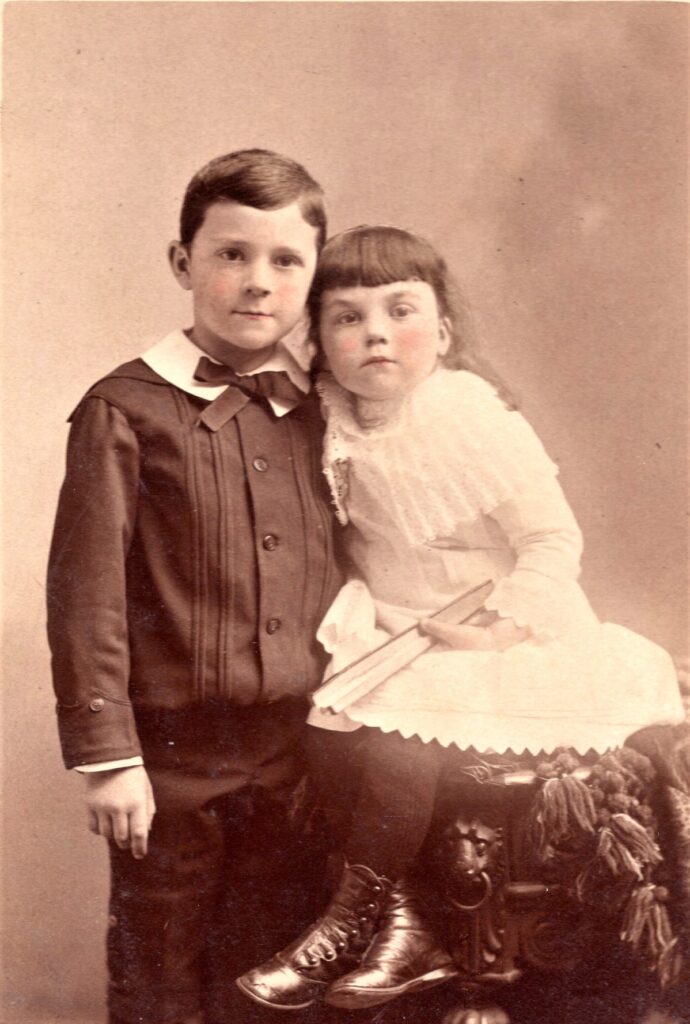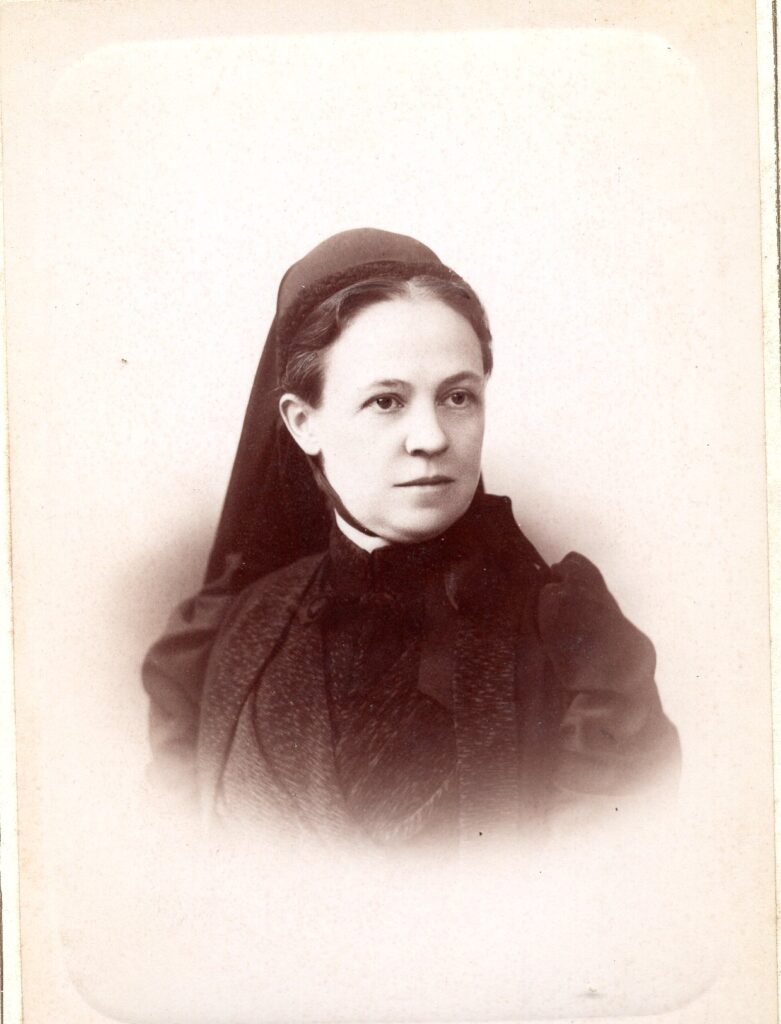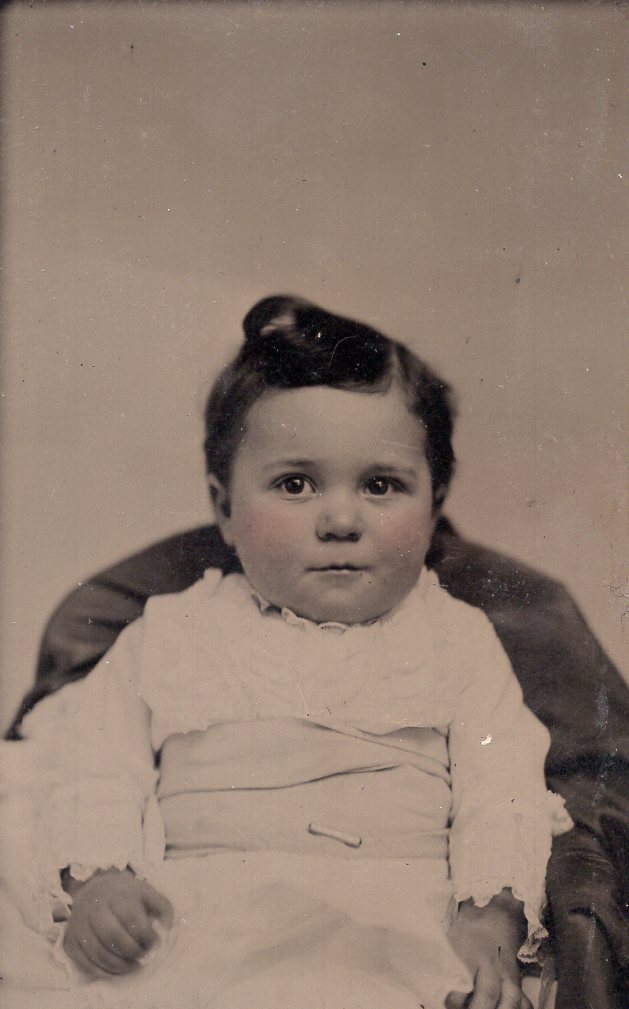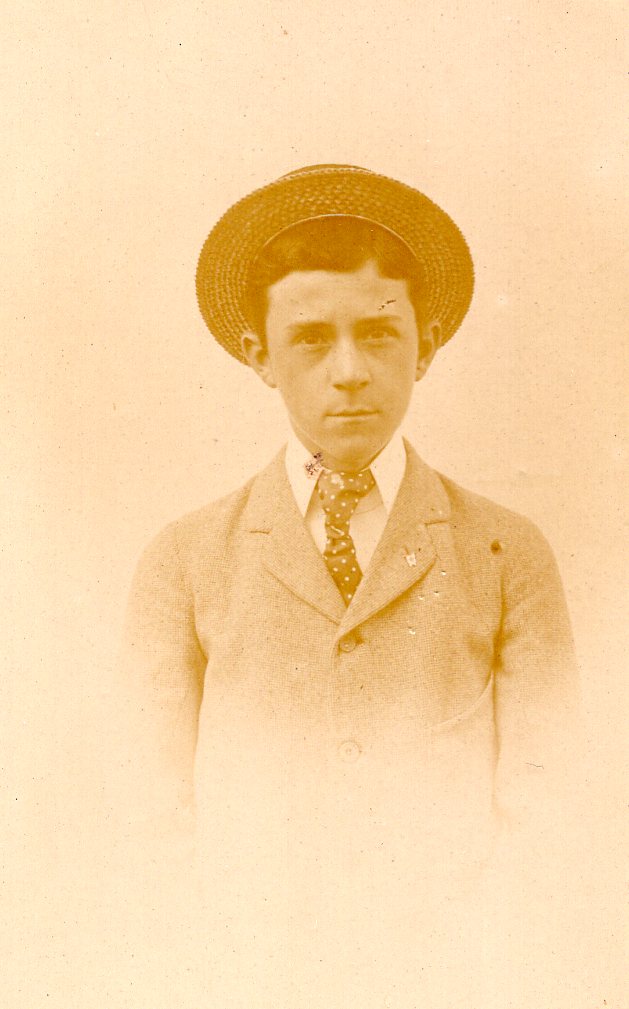Dr. Samuel Shaw’s Family
One can just imagine the conversations that took place in front of the hearth of this dining room. Talk of Dr. Shaw’s patients, the latest scientific discoveries, brother Francis’ travels around the globe, the ever-changing New England weather, world events, local gossip, or the headlines from the New York Times. With the many connections the Shaw’s had, both with local rural folk and with national and international professionals, we know the conversations must have been quite lively. Let’s meet Dr. Shaw’s immediate family.
Some of the following are excerpts from Clara Elizabeth Hudson’s father, Dr. E. Darwin Hudson, taken from The Romances of a Country Doctor, a paper read at the annual meeting of the Northampton Historical Society at the Unitarian Church, Northampton, on October 7, 1947 and from Plain Tales from Plainfield or The Way Things Used to Be, written in 1962. Ms. Hudson was a granddaughter of Dr. Samuel Shaw and the last surviving relative to live in the Shaw Hudson House.
Click on photographs for an enlarged view. All blue text is a hyperlink to more information.
Sarah Snell Bryant Shaw 1802 – 1824
After having spent his entire childhood in Plainfield, Dr. Shaw reluctantly left the town in 1819 to further his study of medicine. Clara Hudson writes, “Dr. Shaw spent the following two years in Boston, attending medical lectures at the esteemed Massachusetts Medical Society. On account of his medical talents he was treated with great attention by two professors: Dr. Warren and Dr. Jackson, and was invited by several families to settle in Boston. But Dr. Shaw had other plans. He missed the hills of Plainfield and in 1821 married Dr. Bryant’s daughter, Sarah. This union was blessed with one child, a daughter, Ellen Theresa Shaw, born at the Bryant Homestead on October 24, 1822.
In 1824 they moved into a home in Plainfield, that today sits diagonal to the Shaw- Hudson House, known as the Winslow Cottage and Dr. Shaw began practicing medicine in Plainfield. Shortly after, tragedy struck when Sarah died of consumption. She is buried in Plainfield’s Hilltop Cemetery and her tombstone bears the following epitaph: “Farewell, Sarah, no rolling sun, shall e’er to me thy life restore. In vain below I seek to find Thy many virtues, now no more.” In her memory her brother William Cullen Bryant wrote the poem, The Death of the Flowers.”
Sarah Snell Bryant was born in Cummington on July 24, 1802. She was the daughter of Dr. Peter Absolom Bryant and Sarah “Sally” Packard Snell Bryant. She was Dr. Shaw’s first wife. They married in 1821 but unfortunately she died of consumption in the winter of 1824 at the age of twenty-two, shortly after the birth of their only child, Ellen Theresa Shaw. She is buried at the Hilltop Cemetery in Plainfield. Dr. Shaw grieved her death for many years.
Ellen Theresa Shaw Mitchell 1822- 1891
Ellen Theresa Shaw was Dr. Samuel Shaw’s only child from his first wife, Sarah Snell Bryant Shaw, daughter of Dr. Peter Bryant. She was born on October 24, 1822 and died March 12, 1891 in Dalton, Massachusetts. She is said to have been the favorite of her uncle, the famous poet, William Cullen Bryant. Although there is evidence that Ellen Shaw visited the Shaw Hudson House often, it is still a mystery as to whether she actually lived in Plainfield after her mother died or moved in with the Bryant family in Cummington.
In 1842, at the age of twenty, she married Clark Ward Mitchell(1818 – 1894). They had one child together, Julia. Mitchell was a Cummington merchant until about 1852, when he and Ellen moved to Dalton, Berkshire County, Massachusetts. He founded the Centennial Mill in Dalton, Massachusetts.
Ellen Theresa Shaw Mitchell died March 12, 1891, in Dalton, Massachusetts at the age of sixty-eight. she is buried in the Main Street Cemetery in Dalton. Her husband, Clark, died March 7, 1894 and is also buried in the Main Street Cemetery in Dalton.
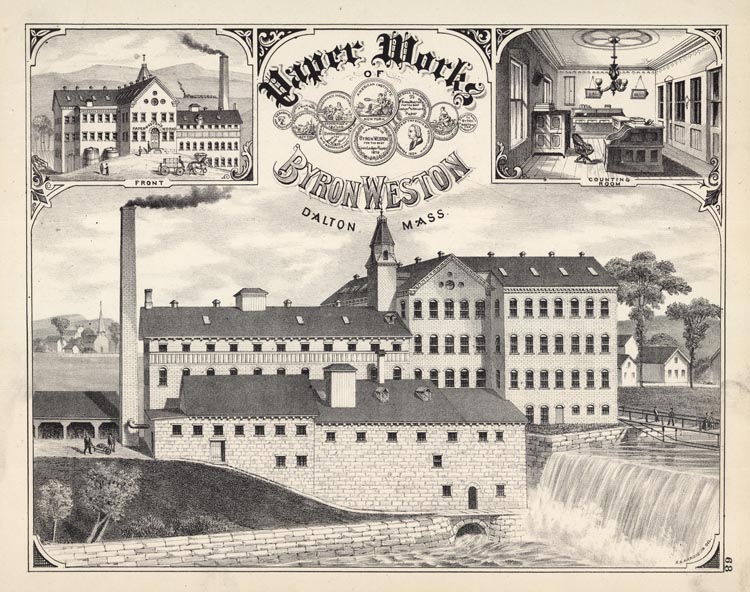
Hand-colored stone engraving, 1876. From the “County Atlas of Berkshire Massachusetts.” by F. W. Beers.
Their only daughter, Julia Carolyn Weston (1877-1937) married Captain Bryon Weston (April 9, 1832 – November 8, 1898). Weston was a native of Massachusetts who founded the Weston Paper Company in 1863 (which ceased to exist following its sale in 2008) and served as the 32nd Lieutenant Governor of Massachusetts from 1880 to 1883. He came from an old New England Congregationalist family of extraordinary wealth. They lived in a mansion known as Westonholme, in Dalton, Massachusetts. Weston was known for his gifts to the community, including to the Grace Episcopal Church in his hometown, donated funds towards the debt incurred for the grading and draining of an athletic field, and a grandstand at Williams College. Weston received an honorary M.A. from Williams College in 1886 and the field, still used today, was named Weston Field in his honor.
The Westons were fashionably rich and frequent guests in the Shaw Hudson house. Julia and Bryon had ten children. Julia’s granddaughter and name sake was the famous cooking author and television personality, Julia Child.
Elizabeth Owen Clarke Shaw – 1799 – 1863
Clara Hudson writes, “In 1830, a colleague, Dr. Joseph H. Flint of Northampton, introduced Dr. Shaw to Elizabeth Owen Clarke. This young lady, after having received a good education, had spent several years in the South engaged in teaching. She also gave important aid, in the preparation of historical charts, to her sister, Miss Anne Laura Clarke, who was the first woman lecturer in the United States. (More on Miss Clark later on in this tour) In 1825 she was in Philadelphia and was present at the reception given to General Lafayette. The death of her brother, Joseph Hawley Clark, in November, 1825, called her home. Here she was occupied with the care and education of his orphaned children when in 1830 she met Dr. Samuel Shaw.
In the letter in which Dr. Flint urged Dr. Shaw to make her acquaintance he wrote “You have the recommendation of easy circumstances, good professional business, an enviable standing in your own neighborhood, and are neither so rude nor unpolished nor go ignorant nor old nor wrinkled but that a sensible woman might even love you as a wife should her husband.” Dr. Flint further gave this alluring description of her character and charms; “Elizabeth Clarke is the daughter of Joseph Clarke who was adopted and educated by Major Hawley (his uncle-in-law) and inherited his estate. She is sister to Anne Clarke, the historical lecturese, a woman of rather extraordinary powers of mind and of very considerable literary acquirement. She is now delivering a course of lectures in Boston. Elizabeth, the younger sister, about twenty three, rather below ordinary size, a good form and not fat. She has a good complexion, brilliant black eyes and shows As fine a set of teeth as you’ve ever beheld. She has been associated with her sister in teaching the young idea how to shoot and is quite proficient in the accomplishments deemed so important in female education, such as music, painting, etc, etc, preserves her spirits and good humor under all circumstances. This is saying a great deal, doctor, of any lady; but I aver it is the truth and nothing but the truth.”
Dr. Flint’s invitation and description evidently proved irresistible, Dr. Shaw came, saw, and soon won the accomplished Miss Clark. This skillful matchmaker saw his scheme crowned with success October 16, 1830, when the handsome doctor carried away the lovely Elizabeth to his mountain home.
In 1865, when Vassar College first opened, Miss Hannah W. Lyman ( 1816-1871) , who was to be the first lady principal, visited, on her way to Poughkeepsie, her second cousin, my grandmother, Elizabeth Clarke Shaw, in Plainfield. She insisted that my grandparents’ youngest daughter, Laura Agnes Shaw, who later became my mother, should go to Vassar for at least one year. My grandfather, Dr. Shaw, had been partially paralyzed by an accident and therefore was not practicing or earning, and it was felt that the expense would be too great. Miss Lyman somehow argued down all objections and Laura went to Vassar.“
Elizabeth Owen Shaw married Dr. Samuel Shaw October 16, 1830, and they went on to have six children: Sarah Elizabeth Shaw; Dr. Samuel Francis Shaw, M.D., Stella Augusta Shaw, Sarah Gertrude Shaw; Charles Lyman Shaw, and Laura Agnes Hudson. Elizabeth Shaw died at the age of sixty-eight of pneumonia on September 27, 1863 at her home and is buried at the Hilltop Cemetery in Plainfield, Massachusetts. We could find no photographs of Elizabeth Shaw.
Sarah Elizabeth Shaw 1831–1834
The first child of Dr. Shaw and his second wife, Sarah Elizabeth Shaw, was born July 16, 1831 and died of unknown causes on September 26, 1834 at the age of three. Her gravestone is located next to Sarah (Bryant) Shaw, Samuel’s first wife.
Samuel Francis Shaw 1833 – 1884
Clara Hudson writes little of her Uncle Francis. As one reads about his life it is no wonder she didn’t know him well, as he was away from Plainfield most of his life. He grew up in the Shaw-Hudson house and did visit the house from time to time in his adult life. Many of his artifacts remain in the house.
Samuel Francis Shaw, the first son of Samuel and Elizabeth Shaw, was born on September 7, 1833 in Plainfield. His early education was with Moses Hallock in Plainfield. Students from Rev. Moses Hallock’s classical school in Plainfield had attended Williams College since its founding in 1793. Francis or ‘Frank’, as he was called, then attended Williams College in Williamstown, Massachusetts and graduated with the class of 1855.
After graduation Samuel Francis spent four years in Plainfield studying medicine and natural history with his father. In 1859 he went to New York City to continue his medical studies at the College of Physicians and Surgeons from which he was graduated in 1862.
He joined the U.S. Navy and served as a surgeon on many ships that took him to the West Indies, Japan, China, and the East Indies. After serving almost 20 years in the Navy he settled in Philadelphia where he continued his profession. He married Adelaide Roberts (1837-1884) from a prominent mining family from Philadelphia. They had no children.
In The History of the Town of Plainfield, C.N. Dyer writes, “Samuel Francis Shaw, son of Dr. Samuel, was born at Plainfield, Sept. 7, 1833. He was fitted for college at the Northampton Collegiate Institute. Entered Williams College in 1852, and was graduated in 1855. After graduation he remained at home four years, studying medicine with his father and making collections of native plants and birds. He studied medicine at the College of Physicians and Surgeons in New York, graduating in 1802.
A few months later he entered the navy as assistant surgeon. During his service of nineteen years he made many long voyages, visiting the West Indies, the Azores, Peru, Sitka, China, Japan and Siberia.
He married Oct. 27, 1877, Adelaide Roberts, daughter of Edward Roberts, Esq., of Philadelphia, and sister of the well-known artist, Howard Roberts, whose statue of Fulton is in the Capitol at Washington.
After spending a year with his wife in traveling through Europe, he resigned his surgeon’s commission and settled in Philadelphia. He died at his home, 1909 Walnut St., on Dec. 7, 1884.
Dr. Shaw was a man of commanding presence. His tall and well proportioned figure, over six feet in height, together with a handsome face which was lighted up by a pair of blue eyes of unusual softness and beauty, attracted universal attention. While his great dignity of character inspired respect, his unselfishness won the affection of all who knew him.” – From History of the Town of Plainfield, Hampshire County, Mass: From Its Settlement to 1891, Including a Genealogical History of Twenty Three of the Original Settlers and Their Descendants, with Anecdotes and Sketches by Charles Newell Dyer.
Dr. Francis Shaw is described as follows in the 1855 William College’s Life Sketches – “SAMUEL FRANCIS SHAW was born in Plainfield, Mass., September 7, 1833. He was a son of Samuel Shaw, for over half a century a practicing physician in Plainfield. His mother was a daughter of Joseph Clarke, Esq., a lawyer in Northampton. Shaw attended the common and select schools of his native town, and finished his preparatory studies at the Northampton Collegiate Institute. He entered Williams at the beginning of Sophomore year, and was graduated with the class.
After graduation, he remained at home (Plainfield, MA), four years, studying medicine and natural history in all its branches, but especially zoology and comparative anatomy. During a considerable part of this time, he suffered more or less from a derangement of the adjusting apparatus of the eyes, which prevented much reading. He, therefore, spent a great deal of his time in the woods and fields, with gun and botanical case, in search of specimens of birds, flowers, etc.
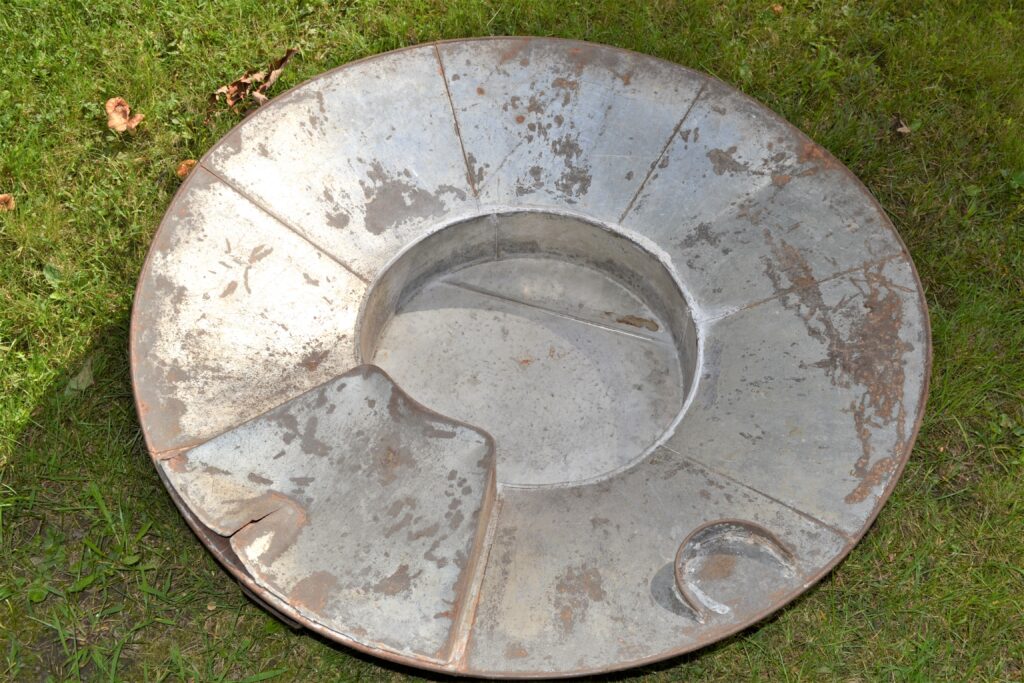
He finally recovered, and in 1859, went to New York City to continue his medical studies in the College of Physicians and Surgeons, from which he was graduated in 1862, serving meanwhile in the Bellevue Hospital as senior assistant and house surgeon. From Bellevue he went to the Harwood Hospital, Washington, D. C., as a contract surgeon, but remained only a short time, as he had already passed his examination for the regular service of the navy, and was soon assigned to duty at the Naval Hospital in Norfolk, Va. In the following spring, he was ordered to join the “Sonoma,” a vessel belonging to the squadron of Commodore Wilkes, in the West Indies, which was engaged in an unsuccessful search for the “ Alabama.” In the summer, the “Sonoma” returned to New York for repairs, and, early in the autumn, joined Admiral Dablgren’s squadron, then blockading the coast of Georgia and the Carolinas. While on the station, Shaw was transferred to the ” Pawnee, and was in several minor engagements off Charleston and elsewhere, as the only medical officer on board. He was in the final operations against Charleston and Savannah, which resulted in the evacuation of both cities, Sherman’s army coming in on the rear.
After two years’ of sea service, Shaw was ordered home, in the spring of 1865, and was soon assigned to duty at the naval academy, then at Newport, R. I. In the autumn, he was promoted from the grade of assistant surgeon to that of passed assistant, and was ordered to the “Florida,” which spent a year in the West Indies, visiting most of the islands and all of the principal ports. During this time, Shaw made his first acquaintance with the yellow fever, personally as well as professionally.
After his return, he was assigned to duty on board the receiving ship “Saint Louis,” at the League Island navy yard, Philadelphia. In about a year, he was transferred to the ” Macedonian,” then fitting out at Annapolis, Md., for a summer practice cruise with the midshipmen. On the cruise, New York, West Point, Fayal and Madeira were visited. From the “Macedonian” he was transferred to the “Onward,” then fitting out at the Mare Island navy yard, California, to be store-ship of the South Pacific squadron, to replace the “Fredonia,” destroyed by the tidal wave following the great earthquake at Arica. He proceeded to California, by way of the Isthmus, and sailed from San Francisco for Callao, Peru. After a long voyage, under sail of sixty-three days duration, he arrived at his destination, having travelled in the preceding six months, over 26,000 miles by sea and land. While on the “Onward” he visited most of the principal places on the western coast of South America.
After about two years on the “Onward,” he volunteered to go on the “Nyack” to San Francisco. The “Nyack” had been three times condemned by boards of survey as unseaworthy, and the recommendation made that she be sold on the coast as being too rotten to take home. The passage was made to Honolulu in forty-four days, and a month was spent in that port. The voyage was then made to San Francisco, in twenty-two days, the vessel very nearly going to the bottom in a heavy gale.
From the “Nyack, Shaw was transferred to the “Saranac,” and made on her a summer cruise along the north-west coast, going up the Columbia as far as Portland, Oregon, making the circuit of Puget Sound, taking the inside passage to Sitka, and even going two or three degrees further north. Returning to San Francisco, to begin the practice of his profession. He has written many official papers on sanitary and medical subjects, which are embodied in the Reports of the Bureau of Medicine and Surgery.
He visited the Yosemite Valley and the Caliveras and Mariposa groves of “big trees.” He came east, in the autumn of 1871, was promoted to the grade of surgeon, and was assigned to the “Michigan,” then at Erie, Penn. Late in the following spring, he was transferred to the naval hospital, New York, and, early in the summer, was again transferred to the torpedo station at Newport, where he remained until the fall of 1873, when he was ordered to report for duty on board the “Kearsarge,” then fitting out at the Mare Island navy yard, for a cruise on the Asiatic station. He made the voyage to Yokohama, by way of Honolulu. While on the station, he visited all the principal places and many of minor interest in Japan, China and the East Indies. With others, he made three trips into the interior of Japan. The “Kearsarge” took Professor Hall’s party, for the observation of the transit of Venus, from Nagasaki to Vladivostok, Siberia, where the vessel remained three months. After being on the station three years, Shaw was relieved and returned home, by the Pacific Mail Company’s steamer to San Francisco, and by the Transcontinental Line to New York. After a year, partly spent in waiting orders in New York and Philadelphia and partly on board the training ship” Minnesota,” in the harbor of New York, he was granted a year’s leave of absence with permission to go abroad, being the first leave ever asked from or granted him by the department.
He was married, in October, 1877, to Adelaide Roberts (1837 – 1884), daughter of the late Edward Roberts, of Philadelphia, and sister of Howard Roberts, the well-known artist. Dr. and Mrs. Shaw spent a year in Europe, passing the winter months in Italy, the spring in France, the summer in Switzerland, Belgium and Holland, and the autumn in Great Britain. Soon after his return, Dr. Shaw was assigned to duty on board the “Saint Louis,” at the League Island navy yard, where he remained upward of two years. In March, 1881, he resigned his commission, after nearly nineteen years in the service, and has settled in Philadelphia, at No. 1909 Walnut Street.“
Dr. Francis Shaw set up a medical practice in Philadelphia. He died December 07, 1884 at the age of fifty-one, possible from complications from bouts of malaria he suffered while in the service. He had no children.
Stella Augusta Shaw 1835-1908 and Sarah Gertrude Shaw 1836-1930
A Plainfield Town map of the 1870s shows that after the death of Dr. Samuel Shaw in 1870 the house was in the name of “Misses Shaw” or as locals called it the “The Shaw Sisters’ House.” Both Stella and Sarah lived out their days here. Neither sister married or had children.
Stella Shaw was born December 13, 1835, in the Shaw-Hudson house and enjoyed her childhood growing up in Plainfield. She died on June 08,1908, at the age of 72 and is buried in the Hilltop Cemetery on Plainfield.
Sarah Shaw was also born in the Shaw-Hudson house on December 17,1836, and died July 27, 1930, at the age of 93. She is buried with her family at the Hilltop Cemetery in Plainfield.
Clara Hudson had many fond memories of her aunts, spending nearly every summer of her childhood with them. She writes: “The way I think of Aunt Sarah is,` She was little, but Oh My!” She weighed 99 pounds but what she lacked in size she made up in determination. For example, she was devoted to the New York Times and if she found an editorial of which she especially approved she hunted me up and read it to me, saying she felt that I must be informed.
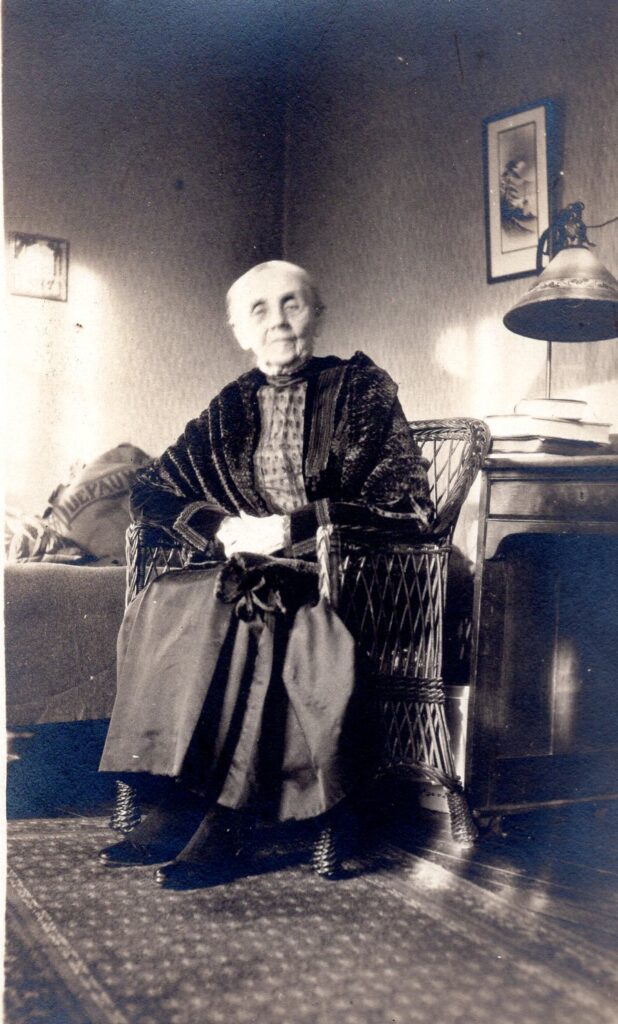
Miss Sarah Shaw age 90. Property of the Shaw- Hudson House collections
She was very “neat and trim,” wore her hair parted in the middle, crimped in front, and in the back arranged it in a sort of flat, braided bun. A favorite expression of hers was “Good Grief !”
Another aunt, Aunt Stella, sister of both my mother and Aunt Sarah, died over twenty-five years before Aunt Sarah. They were respectively ten and nine years older than my mother and were known as the “Shaw girls.” Their church dresses, alike in being of heavy black silk with black satin stripes, trimmed with jet, had black taffeta petticoats which rustled. One of my friends has said that one of her chief desires as a child was to rustle into church as my aunts did. She used to walk in dry leaves, pretending that they were ‘rustly’ skirts.
In order to bring electricity to Plainfield in the 1920’s, a minimum of twenty dwellings had to request installation. Among them was the house of my Aunt Sarah, as well as the new building of the Hallock Memorial School and the Shaw Memorial Library. One afternoon I was asked to go to the new building to help decide the location of the electric fixtures. I left Aunt Sarah, now old and ill, resting on her bed. After an unexpected delay at the library I hurried home, worrying lest she had needed me. To my distress, she was not on her bed nor anywhere upstairs. I finally found “Auntie” sitting in the kitchen with the oven door of the wood-burning cook-stove open and her feet warming on the rack in front.
When I had left for the library, electricians were working in the house and they had promised to take any messages left at the front door. When Aunt Sarah heard the workmen start to pick up their tools around five o’clock, though she had gone downstairs Only three times all summer, she made her way down our rather steep stairs and down a few more steps to the shed which was our garage, where she walked around the men’s car, admiring it. After they drove away she went into the kitchen. Finding the makings of a fire laid in the cook-stove, she got a match, lit the fire, pulled up grandfather’s big Windsor armchair, and toasted her feet in the open oven. Knowing that she would resent a suggestion to return to her bed, I spoke of work I should finish upstairs. “Would Aunt Sarah prefer to stay downstairs alone or go upstairs with me?” “I think I’ll go upstairs with you,” said Auntie.
Before the era of telephones the death of an inhabitant in Plainfield was announced by tolling the church bell, the age of the deceased being indicated by tolling ten “strokes,” then pausing slightly, then another ten strokes, etc. Since telephones had been available for some time, when the bell was tolled for Aunt Sarah in 1930, it was the last time, as far as I know, that this ancient custom was observed in Plainfield.“
Charles Lyman Shaw 1842 – 1902
Most of what we know about Charles Lyman Shaw comes from Clara Hudson’s memories. She writes of her Uncle Charles Lyman Shaw – “Born in Plainfield on February 7, 1842, the son of Dr. Samuel Shaw and Elizabeth Clarke, after being fitted for college in local schools Uncle Charles graduated from Williams College in the Class of 1864 with an average for the four years’ course of 98.59.
He was always a teacher. For three years he was principal of the Norwalk Classical Institute in Connecticut. After an attack of erysipelas had caused a year’s absence from teaching, he established in Astoria (Long Island) the Astoria Latin School, a one room school of which he was the sole teacher. He was a spare, bespectacled, nearsighted, black-mustached man, and when he was annoyed one eyebrow twitched.
During the winter months he used to watch for the combination of a clear evening and freshly fallen snow. When the elements favored he would invite several neighbors in for the evening. First they would have through his excellent glass a view of the moon or Saturn’s rings and then they would “sugar off.” This consisted of pouring upon pans of fresh snow maple syrup which had been boiled until, when poured drop by drop into cold water, it formed into beads. On snow the syrup stiffened into a chewy substance which, though very sweet, was quite delicious.
To my uncle, Charles Lyman Shaw, I owe much of my interest in factual books. Until I went to Barnard College in New York City he was my only schoolteacher, and an excellent one. I have never attended either grade or high school, and until I went to college I had never been in classes with girls. Reciting in a class of fifty girls often brought tears of nervousness to my eyes, whereas reciting with a dozen or more boys hadn’t disturbed me at all.“
Much of Clara’s writings on her Grandfather, Dr. Samuel Shaw comes from conversations with her Uncle Charles, whom she remained close with his entire life. He never married nor did he have children. Charles Lyman Shaw died on May 27, 1902 in Astoria, New York and is buried in Plainfield at the Hilltop Cemetery.
Laura Agnes Shaw Hudson 1846 – 1921
Laura Agnes Shaw was the sixth and last child of Dr. Samuel Shaw. She was born on June 27, 1846, at what would become known as the Shaw-Hudson House. Laura was educated at home by a private tutor and then attended Rutgers Female College on 5th Avenue in Harlem, New York a once prominent institution that was the first chartered women’s college in New York City. She finished her college education at Vassar.
While in New York she met and eventually married Dr. Erastus Darwin Hudson of New York. She was the mother of Helen Darwin Shaw Hudson (1874-1877), Samuel Fowler Hudson (1872 -1880 ), Francis Shaw Hudson (1878 – 1880), Clara Elizabeth Hudson (1880 – 1963) and Paul Hudson, born in 1882, who died at 25 weeks old. Only two of Laura’s children, Clara Elizabeth Hudson and Darwin Shaw Hudson lived to adulthood.
Clara Hudson writes of her mother: “In 1865, when Vassar College first opened, Miss Hannah W. Lyman(1816-1871), who was to be the first lady principal, visited, on her way to Poughkeepsie, her second cousin, my grandmother, Elizabeth Clarke Shaw, in Plainfield. She insisted that my grandparents’ youngest daughter, Laura Agnes Shaw, who later became my mother, should go to Vassar for at least one year.
As Laura needed a new best dress, one was created from a very “rustly” taffeta. The pattern consisted of tiny alternating square of bright blue and midnight blue. Since my Aunts Stella and Sarah were expert needlewomen, they undoubtedly made the dress, trimming it with narrow black velvet ribbon. Vassar girls had only three pegs to hang clothes on, according to Mr. Matthew, Vassar’s dictum. When Laura Shaw had been at college for a few days she was told that the “lady principal” wished to speak to her. What Miss Lyman had on her mind was – “Laura, will you please not wear your blue taffeta gown here at college. It’s too dressy.”
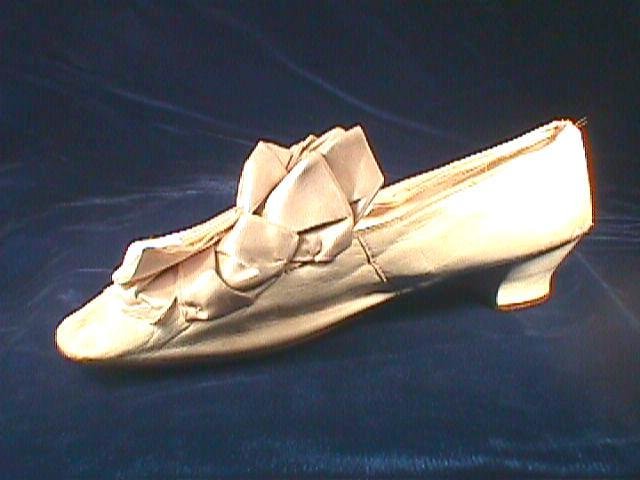
Laura Shaw Hudson was born in Plainfield on June 27, 1846, married Dr. E. Darwin Hudson, from a wealthy family of physicians from New York. . Together they had five children, Helen Turner Hudson (1874-1877), Samuel Fowler Hudson (1872-1880), Darwin Shaw Hudson (1876-1959), Francis Shaw Hudson (1878-1880), Clara Elizabeth Hudson ( 1880-1963) and Paul Hudson (1882 -1882), who died at twenty-five weeks old.
Mrs. Hudson died in April of 1921 at the age of 74 and is buried in Springfield, Massachusetts.
Photographs of Laura Shaw Hudson and Her Children
All photographs are the property of the Shaw-Hudson House Collections

